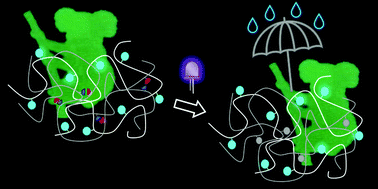Emissive semi-interpenetrating polymer networks for ink-jet printed multilayer OLEDs†
Abstract
Solution-processing of multilayered Organic Light Emitting Diodes (OLEDs) remains a challenge that is often addressed by cross-linking polymer precursors into insoluble networks. Herein, we blend an emissive polymer carrying a Thermally Activated Delayed Fluorescence (TADF) emitter and a host species with a photo-cross-linkable polymer containing ortho-methylbenzaldehyde and maleimide groups as reactive cross-linkers to form a Semi-Interpenetrating Polymer Network (SIPN) upon irradiation at 365 nm. The progress of the cross-linking via Diels–Alder [4 + 2]-cycloaddition is monitored by FT-IR-spectroscopy and is correlated with the solvent resistance of the SIPN. Furthermore, the influence of the molecular weight and the cross-linker content on the efficiency of the cross-linking are investigated. The resulting polymer films show a high solvent resistance evidenced by photoluminescence and AFM measurements and are thus suitable for a successive solution-processed layer. Furthermore, a comonomer carrying the commercial host molecule 1,3-bis(N-carbazolyl)benzene (mCP) was synthesized in high yields, copolymerized and integrated in the emissive SIPN with good resistance against organic solvents. Lastly, the polymer blends were processed with an ink-jet printer and turned into an insoluble SIPN.



 Please wait while we load your content...
Please wait while we load your content...